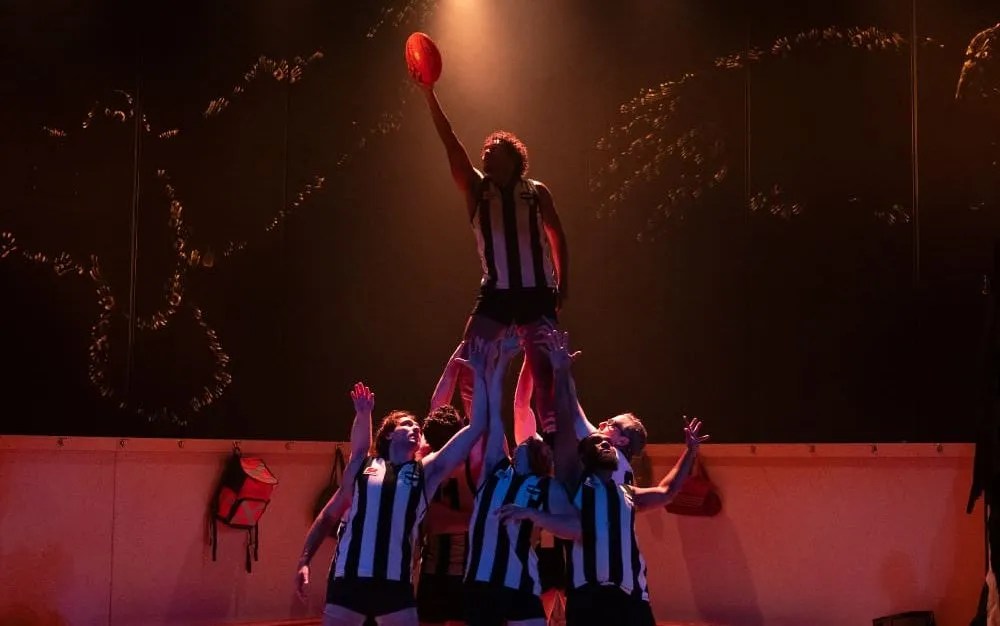Spoiler alert: the following article contains a reference to a pivotal, climatic moment in Nathan Maynard’s play 37.
The Indigenous sport of Australian Rules Football has long been considered a quintessential marker of Australian attitudes and national values. Prime Minister Alfred Deakin, speaking to sporting dignitaries at the Australasian Football Council in 1908, asserted that: “The game is Australian in its origins, Australian in its principle and, I venture to say, essential of Australian development.” Similarly, Australian historian Geoffrey Blainey described the game as bigger than Australia itself, and sports historian Rob Hess reasserted the status of Australian Rules as ‘The National Game’ despite Rugby League being the most popular spectator sport in New South Wales and Queensland.
In a week in which the issue of antisemitic racism dominated national headlines, the Melbourne Theatre Company (MTC) launched a new season of 37. The play is about a perennial underachieving football club in small town Australia. Its hopes and aspirations to win silverware rest on the recruitment of two Indigenous players known as the Marngrook cousins, Sonny and Jayma. Written by Nathan Maynard, a Trawlwoolway playwright, the play reflects on the impact of racism on the lived experience of Indigenous people in the Australian present.
The play draws heavily on the racist controversies and national debates that were generated by Adam Goodes’ experience of racism as a player in the Australian Football League (AFL), and his eloquence in communicating this to the national public. Although he was the most highly decorated Indigenous man ever to play Australian Rules Football, and a former Australian of the Year, Goodes was booed into an early retirement and alienated from the game he loved. This was simply because he spoke up about racism and challenged its presence in both the Australian game and Australian society.

A key characteristic of the response to accusations of racism in Australia is to label its victims and whistleblowers as the racists. In most cases this tactic quickly shuts down debate and collective self-reflection. The artistry of 37 provides a rare space of safety for audiences to think about the long-standing problem of racism targeted at Indigenous Australians.
To a sports historian working in the field of Indigenous Studies, it is clear that Maynard has created a play that is directly informed by the historic role that Indigenous people have played in our national game. While reference to the Adam Goodes story is front and centre, and provides the audience with a well-known point of focus, other less well-known stories are referenced throughout the play. The relationship that develops between the club captain as a respected (white) leader and the Aboriginal players likely references the protective leadership Haydn Bunton Snr provided Yorta Yorta footballer Douglas Nicholls (later Sir Douglas Nicholls KCVO OBE) when he arrived at the Fitzroy Football Club in the 1930s. The recruitment of Aboriginal players as a strategy to deliver premierships undoubtedly is reflected in the decision of coach Kevin Sheedy to bring around 30 Indigenous players to the Essendon Football Club during his long tenure as senior coach.
While Maynard deploys historical references to shape our reflections on racism, he does not need to go back to the 1930s, the 1990s or the 2010s to make comment on the relative powerlessness of Indigenous people in both Australian society and the sport of Australian Rules Football. The Currawongs, the imaginary football club where the story of 37 takes place, is an Anglo-Australian institution. It is led and controlled by white men and governed by the norms of white Australia. The agendas of the coach, the board members, the sponsors and (white) senior players all overshadow those of the Indigenous players who find themselves in the minority.
Read: The 12 best Australian plays of the 21st century
The relationship that emerges between Sonny and Jayma, the Marngrook cousins, and the Currawongs as a football club is limited to one of contractual commitment and is purely transactional, reminiscent of statements made by Voice advocate Megan Davis AC during the Referendum campaign – that Indigenous people overwhelmingly remain unknown and alien. In presenting the structural characteristics of Australian society, and the local football club as an Australian institution, 37 demonstrates that even where Indigenous people can discuss their experience of racism they are rarely, if ever, taken seriously. What they seek to communicate is lost in translation, their experience so different from the ‘Australian norm’ that it is incomprehensible and remains unknown.
The impediments to genuine conversations about racism depicted in the play closely mirror the realities of power inherent in the institutional structures of the Australian Football League and the football industry generally. Indigenous people are restricted to roles at the very bottom of sports power structures. It is an indictment of the football industry that in 2025 Indigenous people largely remain excluded from decision-making processes in board rooms and at the executive leadership level. This is particularly problematic because Indigenous people have limited opportunities to influence decision-making that ensures the right of employees to enjoy a safe workplace.
In 37 it the older white coach, ‘The General’, who determines what is racism and what is not. Similarly it was not Adam Goodes, but Gillon McLachlan and Eddie McGuire, who determined what was racism and what was not.
The play references Indigenous religious beliefs and associated ceremonial practices in a much more significant way than the play Deadly, Unna? and the film adaptation Australian Rules dared to 20 years ago. Depicting tradition is an innovation in the context of theatre. Marngrook, the name of the cousins Sonny and Jayma, refers to a practice that was part of the ceremonial cycles of life that characterised Indigenous societies across what is now the state of Victoria. The practice that settler-colonists took to be ‘sport’ was recorded in detail by numerous observers, including William Thomas, Assistant Protector of Aborigines. Thomas documented the ‘sport’ in official governmental reports and correspondence. Western District-based James Dawson also left us detailed insight into Marngrook in Australian Aborigines: The Languages and Customs of Several Tribes of Aborigines in the Western District of Victoria, Australia (1881).
Some sports historians believe that Marngrook provided the inspiration for Thomas Wentworth Wills to invent codified Australian Rules Football as we now know it. Played with a possum skin ball, the ‘sport’ held significant religious meaning for the Gunditjmara, Dja Dja Wurrung, Woi Wurrung, Boonwurrung and other peoples.
Marngrook had no scoring. Its purpose was theatre, artistry and the beauty of human bodies in motion. It was a practice connected to religious ceremony that paid homage to the ancestors and to Country. The playing of Marngrook ended with the ball being buried in the ground, returning it to Country, returning it to Mother. 37 opens with the practice of burying the possum skin ball and ends when Jayma, instead of kicking a goal to win the Grand Final for the Currawongs, places the Sherrin on the ground, pours a handful of dirt over it and walks from the playing field. High above the action, representations of Bunjil the Eagle and Waa the Crow keep watch on Country, and all that lives and breathes and all that doesn’t.
Read: Theatre review: 37, Southbank Theatre, The Sumner
To me the message of 37 is clear. Australian Rules Football should be about more than winning or losing. It should and could reassert the values inherent in Marngrook and be about Country and the simple recognition that we Australians all share the same place. And by focusing on place instead of race we may have a chance to find peace and comfortable coexistence, instead of indulging the fears and insecurity racial difference instils.
In a time when many Australian politicians feel empowered to spread the hate towards Indigenous Australians, the messages of 37 are needed more than ever. I hope the MTC can see this need and take the play to Shepparton, Alice Springs, Broome and other regional centres where considered discussions of racism are much needed. I also hope 37 is a play made known to young Australians who need to learn about the issues their generation will be required to solve, and which our generation has not yet been able to.
Professor Judd will be part of a free panel event hosted next week by MTC and discussing this topic with former AFL player Nathan Lovett-Murray and DEI leader Rana Hussein. The panel will be held at Southbank Theatre at 6pm on Wednesday 12 February. Bookings are required.





